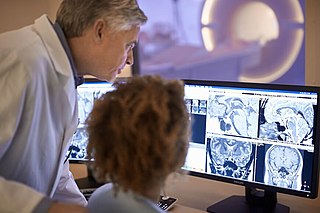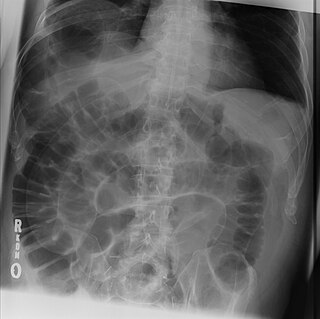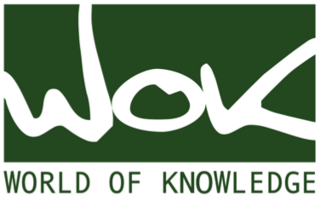
Radiology is the medical specialty that uses medical imaging to diagnose diseases and guide their treatment, within the bodies of humans and other animals. It began with radiography, but today it includes all imaging modalities, including those that use no ionizing electromagnetic radiation, as well as others that do, such as computed tomography (CT), fluoroscopy, and nuclear medicine including positron emission tomography (PET). Interventional radiology is the performance of usually minimally invasive medical procedures with the guidance of imaging technologies such as those mentioned above.

The gestational sac is the large cavity of fluid surrounding the embryo. During early embryogenesis, it consists of the extraembryonic coelom, also called the chorionic cavity. The gestational sac is normally contained within the uterus. It is the only available structure that can be used to determine if an intrauterine pregnancy exists until the embryo can be identified.
The Royal Australian and New Zealand College of Radiologists (RANZCR) is the leading professional organisation for the promotion of the science and practice of the medical specialties of clinical radiology and radiation oncology in Australia and New Zealand. The college has members throughout the world. RANZCR provides the educational curricula for medical graduates training to enter the specialties.

The Radiological Society of North America (RSNA) is a non-profit organization and an international society of radiologists, medical physicists and other medical imaging professionals representing 31 radiologic subspecialties from 145 countries around the world. Based in Oak Brook, Illinois, it was established in 1915.

The agger nasi is a small ridge on the lateral side of the nasal cavity. It is located midway at the anterior edge of the middle nasal concha, directly above the atrium of the middle meatus. It is formed by a mucous membrane that is covering the ethmoidal crest of the maxilla.

In the anatomy of the human digestive tract, there are two colic flexures, or curvatures in the transverse colon. The right colic flexure is also known as the hepatic flexure, and the left colic flexure is also known as the splenic flexure. Note that "right" refers to the patient's anatomical right, which may be depicted on the left of a diagram.

The Royal College of Radiologists (RCR) is the professional body responsible for the specialties of clinical oncology and clinical radiology throughout the United Kingdom. Its role is to advance the science and practice of radiology and oncology, further public education, and set appropriate professional standards of practice. The college sets and monitors the educational curriculum for those training to enter the profession, and administers the Fellowship of the Royal College of Radiologists exams. It is a registered charity in the United Kingdom (no. 211540).

A radiologic sign is an objective indication of some medical fact that is detected by a physician during radiologic examination with medical imaging.

Omental cake is a radiologic sign indicative of an abnormally thickened greater omentum. It refers to infiltration of the normal omental structure by other types of soft-tissue or chronic inflammation resulting in a thickened, or cake-like appearance.

The European Society of Radiology (ESR) is an international medical society based in Vienna, Austria dedicated to the promotion and coordination of scientific, philanthropic, intellectual and professional activities of radiology in Europe. In addition to various other activities, the ESR serves as an umbrella organisation for European radiologists, organises the annual European Congress of Radiology (ECR) and coordinates the publication of European Radiology, a monthly peer-reviewed medical journal. Additionally, the ESR pilots the harmonisation of teaching programmes throughout Europe with various activities and initiatives.
WikiNodes is an app for the Apple iPad built by IDEA.org. WikiNodes was the first tablet app for browsing Wikipedia using a radial tree approach to visualize how articles and subsections of articles are interrelated. The app displays related items, which spread on the screen, as a spiderweb of icons.

A Tornwaldt cyst also spelt as Thornwaldt or Thornwald cyst is a benign cyst located in the upper posterior nasopharynx. It was first described by Gustav Ludwig Tornwaldt. It can be seen on computed tomography (CT) or magnetic resonance imaging (MRI) of the head as a well-circumscribed round mass lying in the midline. In most cases, treatment is not necessary. Indications for treatment include symptomatic lesions, large lesions (>1 cm), or lesions adjacent to the eustachian tube orifice.

World of Knowledge is a global Wikipedia inspired commercial project to enhance learning developed by company WOKcraft based on a community of users creating multiple choice questions for free public use. The abbreviation for the project is WOK and used to market quiz game mobile apps in a social network called the Knowledge Network.

An MRI pulse sequence in magnetic resonance imaging (MRI) is a particular setting of pulse sequences and pulsed field gradients, resulting in a particular image appearance.
Fogging phenomenon in computerized tomography (CT) scanning of the head is vanishing signs of an infarct on the serial CT imaging in a patient with a recent stroke. It is a reversal of the hypodensity on the CT after an acute ischemic stroke. This happens as a result of re-nourishment of the infarcted area in subacute phase about one to three weeks after the stroke. In fact, resolution of the edema, which was caused by the accident, leads to increased attenuation of infarcted area that may regain near-normal density and mask the stroke. However, in the third week, parenchymal volume loss commonly appears as a hypoattenuation with a negative mass effect (shrinkage).
COVID-19 datasets are public databases for sharing case data and medical information related to the COVID-19 pandemic.
The empty delta sign is a radiologic sign seen on brain imaging which is associated with cerebral venous sinus thrombosis. It is usually seen on magnetic resonance imaging (MRI) or computed tomography (CT) scans with contrast. It is seen as dural wall enhancement in the absence of intra-sinus enhancement. This is due to the presence of a blood clot in the dural venous sinuses. The dural venous sinuses drain blood from the brain to the internal jugular veins, which in turn drains blood to the heart. It has been proposed that the empty delta sign occurs in dural venous thromboses due to contrast material filling the dural venous collateral circulation immediately surrounding the dura whilst being unable to fill the intra-dural sinus space due to the presence of a blood clot. The superior sagittal sinus is most commonly affected, but the radiologic sign may also be seen in the transverse sinuses.
Fat suppression is an MRI technique in which fat signal from adipose tissue is suppressed to better visualize uptake of contrast material by bodily tissues, reduce chemical shift artifact, and to characterize certain types of lesions such as adrenal gland tumors, bone marrow infiltration, fatty tumors, and steatosis by determining the fat content of the tissues. Due to short relaxation times, fat exhibits a strong signal in magnetic resonance imaging (MRI), easily discernible on scans.












